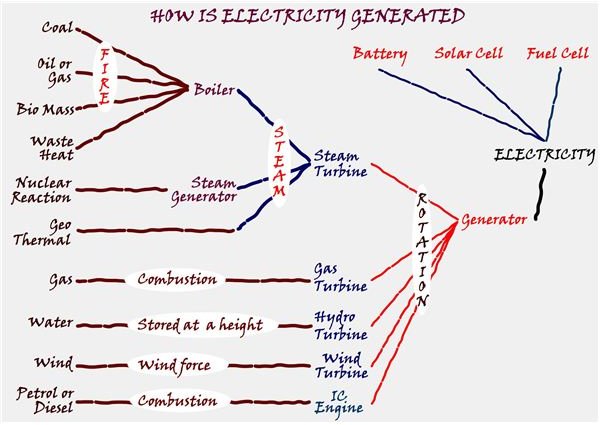How Electricity is Generated in Power Plants?
The basics
There are many methods to generate electricity. The most common and simple method is by a battery, a very familiar household item. This is ideal for very small capacities. To meet the entire domestic, commercial and industrial demand electricity generation has to be done in a large scale in power plants.
Most of the electricity generated in the world is by using an electrical generator. An electrical generator uses the principle of Faraday to produce electricity. Faraday found that a copper coil when moved in a magnetic field produces a voltage across the coil. The electric generator consists of a magnet called the ‘rotor’, which can be rotated inside a copper coil called the ‘stator’ to generate electricity.
To generate electricity we have to mechanically rotate the ‘rotor’. Energy is required to rotate the generator. Energy available in various forms like coal, oil and gas has to be converted to mechanical energy to rotate the generator. This conversion can take place in many different ways. The power plant does this conversion from the primary energy source to mechanical rotation and then to electricity. A small form of this generator is what we have in our car, the alternator. The car’s engine rotates the alternator which generates power for the car. A slightly bigger version is the portable generator driven by a petrol or diesel engine, normally used as a standby in case of a mains power failure.
The different options
In thermal power plants, a steam turbine rotates the generator. This requires the continuous flow of high-pressure steam. Burning fuels like coal, oil or gas produces heat. This heat boils the water in the boiler to produce high-pressure steam. This steam rotates the turbine, which in turn rotates the generator. Burning of other fuels like bio-mass or municipal waste also produces steam for use in the turbine. Waste heat from other process can also produce steam.
Nuclear power plants also use a steam turbine to rotate the generator. Steam generators produce steam by utilising the heat from nuclear fission taking place in a nuclear reactor. Geo-thermal power plants use the steam available from underground geo-thermal reservoirs to rotate the turbine.
It is also possible to rotate the generator directly without a steam turbine using other engines. Internal combustion engines, diesel or petrol driven, can directly turn the generators to produce electricity. The gas turbine power plant uses a gas turbine. The thrust produced from combustion of natural gas rotates the gas turbines, which in turn rotates the generator. This is something like using the thrust from the jet engines of an airplane. In Hydroelectric power plants the energy of water stored at a height in reservoirs created by dams, turn hydro turbines and connected generators to generate electricity. In a wind energy farms, force of the wind turns the wind turbines, which inturn rotates the generators attached to them to produce electricity.
There are other methods to generate electricity without a generator using electrochemical reactions. The most common is the battery in which chemical reaction converts to electricity. In a solar plant, energy from the sunlight is converted directly to electricity by using Solar cells. In a hydrogen fuel cell, chemical reaction between hydrogen and oxygen is used to generate electricity.
All types of power plants cannot be installed everywhere. Availability of the primary energy source is the primary concern. For example, the installation of Wind turbines is done only in places with consistently good wind throughout the year. Also of great concern is the efficiency of conversion from the primary source to final electric output.
The attached mindmap shows the conversion of primary energy sources to electricity.
